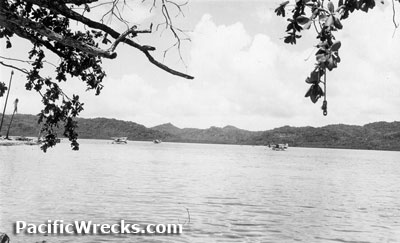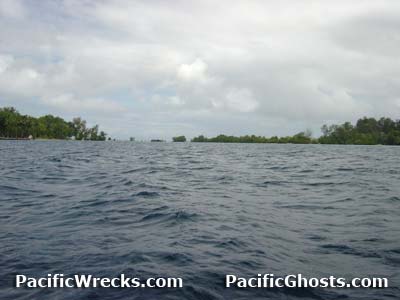|
|
|
|
| Missing In Action (MIA) | Prisoners Of War (POW) | Unexploded Ordnance (UXO) |
| Chronology | Locations | Aircraft | Ships | Submit Info | How You Can Help | Donate |
|
 USN August 7, 1942  USN July 1943  Justin Taylan 2003 |
Location Tulagi Seaplane Base is located in Gavutu Harbor off Guvutu Island and Tanambogo Island. Japanese referred to the base as 'Gabutsu'. Also known as "Gavutu Seaplane Base". Also, the base was sometimes called "Tanambogo Seaplane Base" for the nearby Tanambogo connected by causeway. Many references to this base call it the seaplane base at "Tulagi", but in fact it was located at Guvutu, to the east of Tulagi Island. To the north is Palm (Gaomi). A6M2-N Rufe seaplanes were also moored at Halavo Bay on Florida Island (Nggela Sule). To the west is Halavo Bay and Halavo Seaplane Base. Construction During 1939, the British administration and Royal Australian Air Force (RAAF) built a seaplane ramp and facilities on Gavutu Island for seaplane operations. Wartime History On November 20, 1939 the first seaplane to land at this location was S.23 Short Empire Flying Boat "Centaurus" A18-10 piloted by Captain Gurney from No. 11 Squadron. On July 10, 1940 S.23 Short Empire Flying Boat "Coogee" A18-12 piloted by Captain Purton also made a flight. On January 22, 1942 the first Japanese aircraft attacked Tulagi. During May 1942, Royal Australian Air Force (RAAF) PBY Catalinas from No. 20 Squadron and No. 11 Squadron and were based at Tulagi Seaplane base to patrol the Solomon Islands. On January 13, 1942 at 5:04am PBY Catalina A24-17 took off from Tulagi Seaplane Base on a flight bound for Faisi Island in the Shortland Islands to evacuated an Australian Lt. Gordon H. C. Train who needed medical assistance and returned on January 14, 1942 at 12:49am. Royal Australian Air Force (RAAF) units based at Tulagi Seaplane Base (Gavutu and Tanambogo) No. 11 Squadron (S.23 / PBY detachment) 1939, 1940 No. 20 Squadron (PBY-4 detachment) May 1941–May 2, 1942 Japanese missions against Gavutu January 22, 1942–May 5, 1942 On May 2, 1942 Catalinas from Tulagi spot the Japanese "Shima Force" to the northeast in the Solomon Sea bound for Tulagi and attack but due to bad weather fail to inflict any damage. Meanwhile, the RAAF officer in charge, F/O R. B. Peagam from No. 11 Squadron realized the small detachment of roughly fifty personnel could not opposee the Japanese landing and were order to evacuate and before departing demolish the seaplane base then withdraw to Florida Island and embark on a ship bound for Port Vila on Efaté then onward to Australia. On May 3, 1942 a Japanese flying boat attacks Tulagi and sink the RAAF crash boat. That same day, Imperial Japanese Navy (IJN) 3rd Kure Special Naval Landing Force (3rd SNLF) occupy the area without opposition. Floatplanes from Shortland Harbor Seaplane Base arrive and are moored off Guvutu Island. Meanwhile, an advance party from Yokohama Kōkūtai (Yokohama Air Group) occupies the RAAF facilities on Guvutu Island and Tanambogo Island. Immediately, Tulagi became a main Japanese base in the Florida Islands occupied by 536 Japanese naval personnel from the Yokohama Kokutai and 3rd Kure Special Naval Landing Force, plus Korean laborers and Japanese civilians from 14th Construction Unit. Flying boats and seaplanes of the 25th Air Flotilla: Yokusuka Kokutai and Yokohama Kokutai are moored in two lines off Guvutu and Tanambogo. On July 5, 1942 a detachment of A6M2-N Rufes under the command of Lt. Riichiro Sato from Rabaul arrives and operate from nearby Halavo Bay. Japanese units based at Tulagi Seaplane Base (Gavutu and Tanambogo) Yokusuka Kōkūtai (H6K Mavis det) August 7, 1942 destroyed while moored Yokohama Kōkūtai (H6K Mavis det) Rabaul April 1942–August 7, 1942 destroyed while moored 3rd Kure Special Naval Landing Force (3rd SNLF) landing May 3, 1942–defeated August 7, 1942–August 8, 1942 American missions against Gavutu May 4, 1942–August 7, 1942 Battle of Gavutu On August 7, 1942 at dawn, U.S. Navy (USN) carrier aircraft attack the area and claim seven large flying boats (H6K Mavis) as "burned". U.S. Navy warships bombarded the island, damaging the seaplane ramp. After the U.S. Marine Corps (USMC) landings at Tulagi, at noon, 397 Marines of the 1st Parachute Battalion land on Gavutu. The bombardment damaged the seaplane ramp, forcing the naval landing craft to land the Marines in a more exposed location at a nearby small beach and dock. During the landing, the Marines came under fire from Japanese machine guns on the island and nearby Tanambogo and were attacked during the night. On August 8, 1942 at 10:00am 3rd Battalion, 2nd Marines (3/2), still aboard ships off Guadalcanal, landed on Gavutu as reinforcements. During the Battle for Gavutu and Tanambogo, 476 Japanese defenders and 70 Americans died. Of the 20 Prisoners Of War (POWs) captured, most were Korean laborers pressed into service by the Japanese. Afterwards, several wrecked seaplanes were captured off Tanambogo Island: A6M2-N Rufe 821, A6M2-N Rufe 822, A6M2-N Rufe 826, A6M2-N Rufe 913, A6M2-N Rufe 914, A6M2-N Rufe 915 and A6M2-N Rufe 916. Allied Usage Afterwards, repaired and expanded by the U.S. Navy (USN) for continued use a seaplane anchorage. While in American control, targeted by Japanese aircraft during August 1942 until the middle of 1943. Japanese missions against Tulagi August 7, 1942–June 16, 1943 By June 1943 nearby Halavo Seaplane Base was completed and seaplane operations switched to that location. Also used by the Royal New Zealand Air Force (RNZAF) PBY Catalinas. At the end of the Pacific War, the area was disused as a seaplane operating area. Today Underneath the wharf, the seabed is littered with discarded war relics. Aircraft wings, engines, landing gear and sections of fuselage all stripped of usable parts. A pontoon, what looks like a gun carriage and other larger objects can be found as well as gas masks and smaller pieces. Further away from the wharf, there is the shipwreck of LCM Barge. To the north of Tanambogo Island are several H6K Mavis wrecks sunk August 7, 1942 near their mooring buoys: H6K Mavis (M1), H6K Mavis (M3), H6K Mavis (M5), H6K Mavis (M6), H6K Mavis (M11). Also H6K Mavis (M12) sunk off Guvutu. References Australian War Memorial (AWM) No. 11 Squadron "[1939] The squadron's small flight of Seagull and Empire flying boats immediately began patrolling the Thursday Island, Tulagi, New Zealand, and Bougainville." Australian War Memorial (AWM) No. 20 Squadron "For the remainder of 1942 the unit conducted seaward reconnaissance throughout the New Guinea area, the Solomons, and New Caledonia" The First Team And the Guadalcanal Campaign (1994) pages 35-37 The First Solomons Air Campaign (2024) by Richard Dunn Contribute
Information Last Updated
|
Intel Map July 1942 Captured Japanese Map Photo Archive View on Google Earth |
| Discussion Forum | Daily Updates | Reviews | Museums | Interviews & Oral Histories |
|